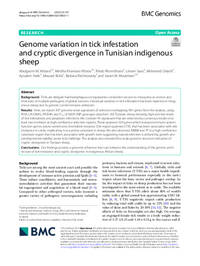Genome variation in tick infestation and cryptic divergence in Tunisian indigenous sheep

Authors:
Background: Ticks are obligate haematophagous ectoparasites considered second to mosquitos as vectors and reservoirs of multiple pathogens of global concern. Individual variation in tick infestation has been reported in indigenous sheep, but its genetic control remains unknown.
Results: Here, we report 397 genome-wide signatures of selection overlapping 991 genes from the analysis, using four methods (ROH, LR-GWAS, XP-EHH, FST), of 600K SNP genotype data from 165 Tunisian sheep exhibiting high and low tick infestations and piroplasm infections. We considered 45 signatures that were detected by consensus results of at least two methods as high-confidence selection sweep regions. These spanned 104 genes which included immune system function genes, solute carriers and chemokine receptor. One region spanned STX5, that has been associated with tick resistance in cattle, implicating it as a prime candidate in sheep. We also observed RAB6B and TF in a high confidence candidate region that has been associated with growth traits suggesting natural selection is enhancing growth and developmental stability under tick challenge. The analysis also revealed fine-scale genome structure suggesting cryptic divergence in Tunisian sheep.
Conclusion: Our findings provide a genomic reference that can enhance understanding of the genetic architecture of tick resistance and cryptic divergence in indigenous African sheep.
